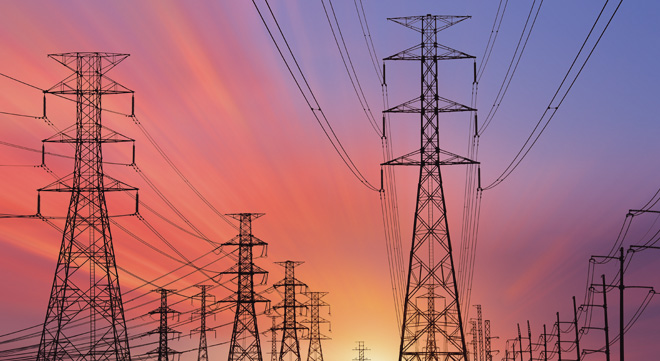The exclusion of damage relating to grid collapse from insurance covers should be understood in the context of changes in the broader operating environment, not only because grid collapse is an uninsurable risk, Viviene Pearson, the chief executive of the South African Insurance Association (SAIA), told a webinar on grid exclusions hosted by FAnews on Wednesday.
The risk of a total collapse of the national electricity grid is very low, despite the impression given by reports in the media, said electrical engineer Monique le Roux of the Energy Centre at the Council for Scientific and Industrial Research.
Le Roux explained how loadshedding is a carefully managed and largely automated process, designed to balance supply and demand across the grid.
The public was being misled by reports suggesting that Eskom staff would be caught napping and lose control of supply and demand, resulting in a grid collapse. Media reports scaremongering about a grid collapse often quote people who are not electrical engineers or who do not know how the national grid is managed, Le Roux said.
In her view, it was “incredibly unlikely” that South Africa would experience a total grid collapse.
Lower appetite for risk
If the risk of grid collapse is low, why have many insurers introduced grid-failure exclusions?
Pearson explained how insurers were having to cope with a new risk landscape in which grid collapse was but one factor.
As a result of persistent loadshedding, insurers could no longer regard grid collapse as an unforeseen risk. Grid collapse was a systemic risk that would have a huge impact on the insurance industry.
If the grid failed, the entire “ecosystem” would be disrupted: telecommunications, and water and fuel supplies. There was a high likelihood of riots and looting, and it could take Eskom 14 to 21 days to get the grid fully operational again.
SAIA had attempted to put a figure to insurers’ potential exposure in the event of a grid collapse. Brokers stopped counting at R100 billion because there are so many covers and variables, and many ripple effects in terms of cover. In SAIA’s view, insurers’ exposure is unquantifiable, and grid collapse is deemed to be an uninsurable risk, Pearson said.
One of the factors informing the introduction of grid-collapse exclusions is the lesson insurers learned from Covid-related business interruption claims: the need for contract certainty. Insurers want to ensure that policies are clear on what is and what is not covered, Pearson said.
The risk landscape for insurers and reinsurers changed significantly following the 2021 riots – and the high risk of more unrest – and the floods in KwaZulu-Natal in 2022. Other trends affecting the appetite for risk are high inflation, low economic growth, the weakness of the rand against major currencies (which affects the cost of imported parts), higher claims volumes related to loadshedding, the disruption of global supply chains since Covid, and higher construction costs.
These trends, as well as the possibility of grid collapse, are making South Africa less attractive for reinsurers, which have indicated that grid failure is not an insurable risk, Pearson said.
Common policy wordings?
Individual insurers have adjusted their grid failure and loadshedding covers, with most introducing a general exclusion for grid failure. Although cover has been removed, premiums have not been reduced, apparently because grid failure was not specifically provided for in the first place, Pearson said.
She said the insurance industry was concerned about reputational damage: policyholders were unhappy because covers were being removed but premiums continued to increase.
SAIA has had “candid discussions” with the regulators and National Treasury about “unrealistic expectations” of what insurers can and cannot do, Pearson said. There was a perception among consumers that insurers only looked after their profits and left policyholders in the lurch when things became difficult. However, it was essential that the insurance industry remained sustainable for individuals and businesses and the well-being of the economy, she said.
Two key issues for SAIA were educating consumers and providing them with policy certainty when it came to loadshedding and grid collapse.
Brokers were finding it difficult to advise clients on what was and was not covered because insurers have different policy wordings, in line with their different risk appetites, Pearson said.
SAIA commissioned a study to find out whether it would be legally possible to introduce common wordings. The study suggested the Competition Commission would deem this to be a collusive practice, she said.
Concerns about Sasria’s decision
SAIA was engaged in discussions with the South African Special Risk Insurance Association (Sasria) about its decision – subsequently withdrawn – to stop covering damage related to a grid collapse from 1 June, Pearson said.
Read: Update: Sasria U-turn on cover for damages related to electricity grid collapse
Sasria withdrew the decision after insurers said they had not been given enough time to change their systems and inform clients, she said.
The July 2021 unrest significantly diminished Sasria’s financial position, leading National Treasury to grant it a bailout of R22bn in the 2021/22 financial year. The funds ensured that Sasria was able to cover its total claims of R32bn and helped the insurer to recover its solvency ratio in line with the requirements of the Prudential Authority.
Pearson said Sasria was subject to the same regulations as other insurers and needed to have sufficient reserve capital to cover its risks. At the same time, insurers have huge concerns over the impact on businesses and investment if Sasria withdraws grid-collapse cover.
There were ongoing conversations between Treasury and Sasria, and one proposal was that Sasria provided “a minimum level of cover”, she said.
Brokers and clients need clarity
Seamus Casserly, the chief executive of Lockton South Africa, drew attention to the challenges facing brokers, who are trying to advise clients on what insurers do and do not cover when it comes to a grid collapse. Every insurer has its own policy wording, which does not provide policy certainty. This also makes it difficult for brokers to advise clients on which insurer provides better value, in terms of the level of cover relative to the premium.
One of the important grey areas in the new policy wordings is the impact of the grid-collapse exclusion on other covers. If a grid failure resulted in a burglar alarm not working, did that mean the policyholder was not covered for theft? If smoke detectors and sprinklers did not work, did the policyholder lose fire cover? Did the exclusion apply only during a grid failure, or afterwards?
Until the grey areas and omissions were addressed, Casserly said brokers should manage client expectations by giving them the worst-case scenario: they would not be covered.
He said the Financial Intermediaries Association has lobbied the FSCA and National Treasury for consistency and clarity in grid-exclusion policy wordings.






I cannot understand why brokers and client alike do not understand the clarity.
for me it is very clear. Insurance covers 2 things:
– Acts of GOD.
– a specific client.
Insurers cannot and may not cover the incapability of a Government i.e bad roads, Eskom etc.
very clear to me and I explain that to clients.
This sounds the same as saying if your car get stolen, its the government failure to ensure there is no crime and there it must not be covered as its not act of God. Surely its not about that, its all about people trying to cover the risks that they do not have appetite for.